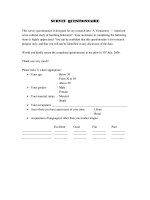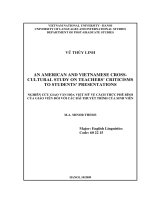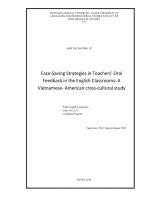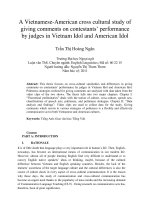A Vietnamese - American cross-cultural study on disparaging
Bạn đang xem bản rút gọn của tài liệu. Xem và tải ngay bản đầy đủ của tài liệu tại đây (287.03 KB, 8 trang )
A Vietnamese - American cross-cultural study
on disparaging
Nguyễn Thị Hồng Vân
Trường Đại học Ngoại Ngữ
Luận văn ThS. Chuyên ngành: English Linguistics; Mã số: 60 22 15
Người hướng dẫn: M.A. Phan Thị Vân Quyên
Năm bảo vệ: 2010
Keywords: Văn hóa Việt Nam; Văn hóa Mỹ; Giao văn hóa; Giao tiếp
Content:
PART A – INTRODUCTION
1. RATIONALE
Vietnamese learners usually find it difficult to communicate appropriately in English with native
speakers, especially American people despite their language competence. Shyness and lack of
confidence are common problems facing Vietnamese learners. They sometimes even can not
understand native speakers and feel uncomfortable to express themselves in particular situations.
This partly originates from the lack of socio-cultural knowledge and interaction skills among
Vietnamese learners.
The differences between western and eastern culture can be referred to as a reason why
Vietnamese learners often fail in communicating with native speakers. Asian learners are not
familiar with western cultural norms.
It is concluded that language and culture have a close relationship. Even an English-competent
learner needs cultural knowledge of the target language to be successful in communication.
Therefore, learning about the target culture, and especially the differences between the source
and target cultures is an effective way for us to master the target language. Cultural knowledge
will help us to avoid misunderstanding, culture shock and breakdown in communication.
A number of studies have been carried out so far on English-Vietnamese cross-cultural
pragmatics / communication by Vietnamese authors such as Conveying Good and Bad News
(Quang, 1992), Requesting (Thanh, 2000), Apologizing and Responding to Apologies (Phuong,
1999), Requesting (Tam, 1998), Greeting (Suu, 1990; Nguyen, 1997), Advising (Le, 1999),
Thanking and Responding to Thanks (Hoang, 1998), Refusing a Request (Quyen, 2001),
Expressing Sympathy (Nga, 2003), Making Suggestions (Lam, 2004), Expressing Annoyance
(Phung, 2006), Promising (Be, 2008), but no research has been conducted on disparaging.
There is a good reason for the choice of this act because it is a face-threatening act. Therefore, it
requires much sensitivity and cross-cultural awareness in order to gain effective communication
without hurting the listeners.
This research will hopefully provide learners as well as teachers and people working in
intercultural environment with better understanding of the nature of this behavior across cultures
and ability to reduce to the least negative effect on cross-cultural communication, and most
importantly, to communicate safely and effectively.
2. AIMS OF THE STUDY
To investigate the way Vietnamese people and American people disparage in given
situations
To clarify the most noteworthy similarities and differences in the ways Vietnamese and
American people disparage in their own languages and cultures.
3. RESEARCH QUESTIONS
The research plans to address the following questions:
Question 1: How do American and Vietnamese people disparage in different situations and with
different communicating partners?
Question 2: What are the most noteworthy similarities and differences in the ways Vietnamese
and American disparage in their own languages and cultures?
4. SCOPE OF THE STUDY
The thesis focuses on strategies of expressing disparagement in Vietnamese and American
culture. Responding to disparagement is beyond the scope of this study.
The author is fully aware of the remarkable contribution of paralinguistic and extralinguistic
aspects of disparaging, however, they are not taken in to consideration.
The Vietnamese Northern dialect and American – English are chosen for contrastive
analysis.
The data are collected by conducting survey questionnaires both in English and Vietnamese,
based on socially-differentiated situations in which disparagement takes place and three
groups of informants in social, business, and family status. Recorded and video taped face-to-
face conversations are impossible due to limitations of time, geographical distance and
financial difficulties.
5. METHODOLOGY
In order to achieve the objectives of the cross-cultural research, the main method of the study is
survey research. All the considerations, comments and conclusions in this thesis are largely
based on:
- reference to relevant publications
- survey questionnaires
- statistics, description and analysis of the collected data
- personal observation
- consultation with supervisor
- discussion with Vietnamese and foreign colleagues
6. DESIGN OF THE STUDY
The thesis consists of three main parts:
Part A: INTRODUCTION – All the academic routines required for an MA thesis are presented
PART B: DEVELOPMENT – This is the focus of the study and consists of 3 chapters
Chapter 1: Literature Review
Chapter 2: Methodology of the study
Chapter 3: Strategies of disparaging
Part C: CONCLUSION: Review of the findings, implications and limitations of the study and
some suggestions for further research.
BIBLIOGRAPHY
In English
1. Adler, P. 1972. Culture Shock and the Cross-Cultural Learning Experience. International
Education Vol.2.
2. Austin J.L 1962. How to Do Things with Words. Cambridge University Press.
3. Bach, K. and Harnish, R. 1984. Linguistic Communication and Speech Acts. The MIT
Press.
4. Bentahila, A. and Davies, E. 1998. Culture and Language Use. IRAL Journal, VOL.
XXVII/2, MAY.
5. Blum Kulka, S. and Olshtain, E. 1984. Requests and Apologies: a cross- Cultural Study
of Speech Acts Realisation Patterns (CCSSARP). Applied Linguistics, Vol.5 – No 3.
6. Blum Kulka, S. 1987. Indirectness and Politeness in Requests: Same or Different?
Journal of Pragmatics II. North Holland.
7. Bock, P.K.1970. Culture Shock. Alfred A. Knoff. Inc.
8. Brown, G. and Yule, G.1989. Discourse Analysis. Cambridge University Press
9. Brown, P. & Levinson, S. 1987. Politeness: Some Universals in Language Usage.
Cambridge University Press.
10. Byram, M. and Flemming, M. 1998. Language Learning in Intercultural Perspective.
Cambridge University Press.
11. Canale, M & M. Swains. 1980. Approaches to Communicative Competence. SEMEO
Regional Language Centre.
12. Chomsky, N. 1965. Aspect of theory of syntax. Cambridge, Mass. MIT Press.
13. Clyne, M. 1981. Culture and Discourse Structure. Journal of Pragmatics 3, pp.61-66
14. Cook, G. 1990. Discourse. Oxford University Press.
15. Conttrill, L. 1996. Face, Politeness and Directness. University of Canberra.
16. Crystal, D. 1996. The Cambridge Encyclopedia of Language. Cambridge University
Press.
17. Frawley, W. 1992. Linguistic Semantics. Lawrence Erlbaum Associates Publishers
18. Ellis, C. 1996. Culture Shock! Vietnam. Times Editions Pte Ltd, Singapore.
19. Green, G.M. 1989. Pragmatics and Natural Language Understanding. LEA.
20. Grundy, P. 2000. Doing Pragmatics. Oxford University Press.
21. Gumper (in Wardhaugh, R.). 1992. An Introduction to Sociolinguistics. Basil Blackwell.
22. Haines, S. and Steward, B. 1994. First Certificate Masterclass. Oxford University Press.
23. Hymes, D. 1996. Language in Culture and Society. Harper International Edition.
24. Hymes, D. 1978. On Communicative Competence. In J.B Dride and H.Holmes.
25. Kaplan, J. 1972. Cultural thought patterns. Intercultural Education in Language
Learning, 16, pp. 1- 20.
26. Kasper, G. 1997. Linguistic Etiquette. The Handbook of Sociolinguistics, edited by
Florian Coulams, Blackwell Publishers.
27. Keller, E. and Warner, S.T. 1998. Conversation Gambits. Language Teaching
Publications, Canada.
28. Kramsh, C. 1998. Language and Culture. Oxford University Press.
29. Lado, R. 1957. Linguistics across Cultures. Ann Arbor – The University of Michigan
Press.
30. Lakoff, R. 1997. What Can You Do with Words: Politeness, Pragmatics and
Performatives.
31. Leech, G. 1983. Principles of Pragmatics. Longman: London and NewYork.
32. Levine, D.R. and Adelman, M.B. 1993. Beyond Language – Intercultural
Communication for English as a Second Language. Prentice Hall Regends.
33. Levine, D.R., Baxter, J. and McNulty, P. 1987. The Culture Puzzle – Cross Cultural
Communication for English as a Second Language. Prentice Hall Regends.
34. Levinson, S.C. 1983. Pragmatics. Cambridge University Press
35. Nguyen Quang. 1998. Intercultural Communication. VNU – CFL.
36. Porter, R. and Samovar, L.A. 1985. Intercultural Communication: A Reader (4
th
edition).
Belmont, Ca: Watsworth.
37. Prodromou, L. 1992. What culture? Which culture? Cross – Cultural Factors in
Language Learning.
38. Searle, John R. (1965) “What is a Speech Act?” In The Philosophy of Language. Pp.
130-140. edited by A.P. Martinich, Oxford: Oxford University Press.
39. Searle, John R. 1969. Speech acts: an essay in the philosophy of language. London:
Cambridge University Press.
40. Searle, John Rogers, 1971. edited by. The philosophy of language. London: Oxford
University Press.
41. Searl, J.R. 1975. A Taxonomy of Illocutionary Acts – In K.Gunderson (ed.) Language,
Mind and Knowledge. Mineapolis: Cambridge University Press.
42. Searl, J.R. 1975. Indirect Speech Acts – In Cole and L. Morgan (eds.), Syntax and
Symantics 3: Speech Act. New York: Academic Press.
43. Searle, John Rogers. 1976. A Classification of illocutionary Acts: Language in Society 5
pp.1-23.
44. Searle, John Rogers. 1979. A Taxonomy of Illocutionary Acts: In The Philosophy of
Language. pp. 141-155. edited by A.P. Martinich, Oxford: Oxford University Press.
45. Tillitt, B. and Bruder, M.N. 1995. Speaking naturally. Cambridge University Press.
46. Ting – Twomey, S. 1999. Communicating Cross Cultures. New York and London: The
Guiford Press.
47. Thomas, I. 1995. Meaning in Interaction: An Introduction to Pragmatics. London and
New York, Longman.
48. Valdes, J.M (ed). 1995. Culture Bound. Cambridge University Press.
49. Wanning, E. 1991. Culture Shock! America. Times Editions Pre Ltd, Singapore.
50. Weirzbicka, A. 1985. Different Cultures, Different Languages, Different Speech Acts.
Journal of Pragmatics 9, 145 – 1978.
51. Weirzbicka, A. 1987. English Speech Act Verbs. Academic Press, Australia.
52. Weirzbicka, A. 1991. Cross – Cultural Pragmatics: The Semantics of Human Interation.
Berlin, New York: Mouton de Gruyter.
53. Wright, A. 1987. How to Communicate Successfully. Cambridge University Press.
54. Yule, G. 1996. Pragmatics. Oxford University Press.
In Vietnamese
1. Đỗ Hữu Châu. 1995. Giáo trình giản yếu về dụng học. NXB Giáo dục.
2. Đỗ Hữu Châu. 1995. Các yếu tố dụng học của Tiếng Việt: Tạp chí Ngôn Ngữ số 4/ 95.
3. Hoàng Tuệ. 1996. Ngôn ngữ và đời sống xã hội - văn hóa. NXB Giáo dục.
4. Nguyễn Văn Chiến. 1992. Ngôn ngữ học đối chiếu và đối chiếu các ngôn ngữ Đông Nam
Á. Trường Đại học Sư phạm Ngoại Ngữ Hà Nội.
5. Nguyễn Văn Chiến. 2000. Giao văn hóa và giảng dạy ngoại ngữ: Kỷ yếu hội thảo khoa
học quốc gia: “Thành tố văn hóa trong dạy học ngoại ngữ”. Trường Đại Học Ngoại Ngữ -
ĐHQG Hà Nội.
6. Nguyễn Quang. 1996. Một số phạm trù giao thoa văn hóa Việt Mỹ trong hoạt động giao
tiếp. Tập san Ngoại Ngữ số 4/96.
7. Nguyễn Quang. 2002. Giao tiếp và giao tiếp giao văn hóa. NXB Đại học Quốc gia Hà
Nội.
8. Nguyễn Quang. 2003. Một số phương pháp nghiên cứu giao tiếp nội văn hóa và giao văn
hóa. Trường Đại Học Ngoại Ngữ - ĐHQG Hà Nội.









